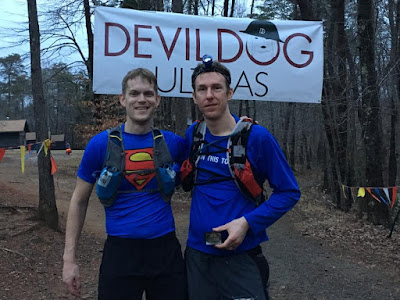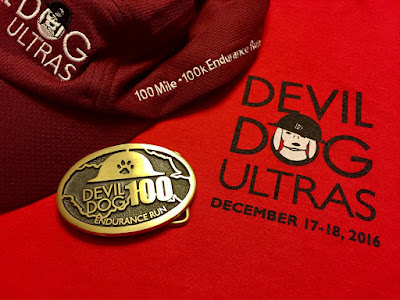Redemption ain't easy. I was having a tough time forgiving myself for an unfortunate DNF ("did not finish") at
Pine to Palm in September and knew that nothing short of a 100 mile finish before the end of 2016 would fill that void. As I searched for a viable option, the
Devil Dog 100 miler in Virginia presented itself as the perfect opportunity. Despite being in its inaugural year, I knew many of the volunteers and race direction staff. In addition, the course's loops of rolling hills provided easy logistics that should surely facilitate a high finishing rate, perhaps even a new 100 mile PR (personal record). As long as the weather cooperated—December in Virginia is typically mild—I knew I’d be in good shape. I couldn’t have been more wrong.
 |
| A cold and icy start prior to sunrise. Photo credit: David Potts. |
Of the 105 runners who started the 100 miler, only 39% would cross the finish line. Freezing temperatures overnight combined with rain in the morning hours of the race resulted in icy conditions everywhere. The second night saw welcomed yet bizarre weather, with temperatures rising into the 50s.
 |
| Loop 1 done, and already tired. Photo Credit: David Potts |
The Devil Dog 100 mile course was 5 loops with about 80% singletrack and 20% gravel roads; there was also a 3 loop 100 km option. There were three full service aid stations per loop, with three more water only self-serve stops. Drop bags and crew opportunities were plentiful, though I opted to just leave a large bag at the start/finish. While I didn't have a crew, the volunteers gladly handled every one of my needs and always had warm food ready. There were no major climbs, however with consistently rolling terrain the elevation added up. The gain/loss was listed at 10,000 feet, though some runners claimed over 12,000.
The venue, Prince William Forest, provides a natural respite from sprawling D.C. suburbia featuring 16,000 acres and over 40 miles of running trails. Beyond its natural appeal, runners traversed some interesting history as well. The Devil Dog course weaves its way past a
defunct pyrite mine, which earned workers a handsome $4.00 per day in the early 1900s. Three small towns once existed within the park boundaries, now all extinct. Finally, the
Office of Strategic Services, the precursor to the modern day Central Intelligence Agency, once trained agents in the art of espionage here.
Having never run a looped race before, I wasn't sure what to expect and each loop had its own unique set of challenges. The freezing rain on loop 1 turned the course into a skating rink, forcing runners to tip-toe or crawl at times. I used a technique mimicking cross country skiing to cross the roads and walkways, holding 11th place after loop 1.
About halfway through loop 2, the ice was beginning to melt but I was faced with a new problem. All that slipping and sliding had worn my stabilizer muscles out beyond belief. I found that fresh legs are not helpful when the attached hip, glute, and lower back muscles are exhausted beyond repair. The 3rd loop was my most enjoyable and I moved into 9th place. During full daylight, and no ice to contend with, I was able to run more consistently, listening to music as I crossed the halfway point.
 |
| Proudly finished, alongside my pacer Jake Kruse. Still feeling a bit dazed. |
Darkness set in by the time I picked up my pacer at the start of loop 4. This was a harsh reminder that with 14 hours of darkness, December nights are long. Not far into loop 4 something broke inside of me and I was reduced to a hobble. Rallying to a speed walk I trudged on, relying only on constant forward progress. Dizziness and nausea added to my stresses. Leaving the last aid station and with 6.5 miles left in the loop I was faced with the possibility of walking all of loop 5. The thought of spending the next 10 hours walking felt mentally defeating. I still had plenty of time before any cutoffs and I was committed to finishing, either by running, walking, or crawling. A few miles into loop 5 I experienced some ultra magic: I became less tired, the nausea dissipated, and a welcomed dose of pep returned to my legs. Now back to a mostly-running strategy, I patiently moved along. The mile 87 AS told me I was in 7th place. The final half-marathon just consisted of some steady walk-running, a quick stop at the final AS, and then a few last trying miles leading up to the finish area. Finally, I crossed the finish line at 7:25 a.m. in 25:25:10 total, good enough for 6th place, as I had unknowingly passed the aforementioned runner in front of me.
 |
| My friend and training partner Samantha Pitts-Kiefer finishing strong. |
My 4th 100 mile finish gave me some key takeaways. Support matters: the volunteers here were incredible. I had only arranged for a pacer a couple weeks prior as a luxury, but he proved to be an invaluable necessity. Next was that music works, and can get you through long solo lulls given the proper playlist. My nutrition strategy is starting to solidify; I never got particularly hungry and didn't linger too long as ASs. Most importantly, the more difficult the experience is, both mentally and physically, the more satisfying the finish. I had redeemed myself, righting my wrong from earlier this year, taking me into winter feeling accomplished and ready for the next challenge.
 |
| Race swag, and the coveted belt buckle. |
Full results available via
Ultra-signup.












